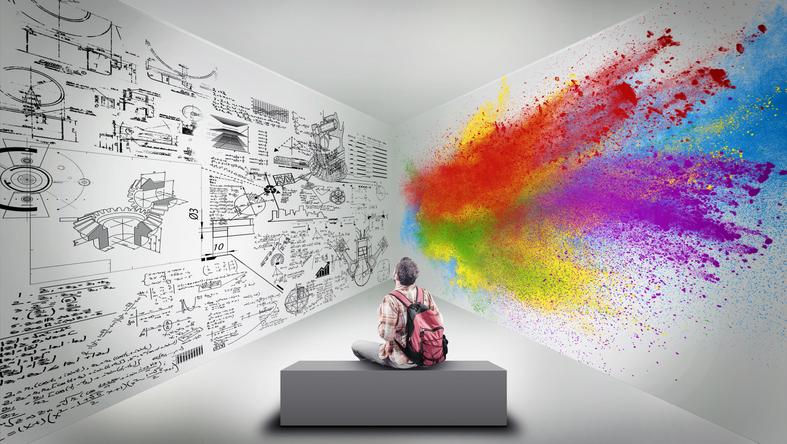Human beings experience different situations throughout their existence. Some decisions are not easy to make from the perspective of reality itself. Faced with a reductionist view of this issue, it is possible to integrate creativity as a means to resolve this issue. Lateral thinking leads to this purpose that allows the human being to reach a conclusion through its own methodology. In PsychologyFor, we reflect on the nature of this term formulated by Edward de Bono that shows a different path to get to the main question in solving problems by adding imagination. In this article we reflect on this topic: Edward de Bono and lateral thinking<
Edward De Bono: creator of lateral thinking
Edward De Bono, graduate in Medicine and specialist in Psychology, was born in Malta in 1933. He is the author of reference books. In “Creative thinking” he delves into the essence of lateral thinking as a means of innovation to develop new proposals. Lateral thinking or divergent thinking reflects a different look at reality, a vision that breaks with the scheme of predictable logic to go deeper beyond this aspect.
Faced with the analytical interpretation of reality, creativity is the basis of progress in the present and in the future. Therefore, this ingenuity represents the vision of a new paradigm from which to visualize new paths.
The importance of this vision is vital, for example, in the entrepreneurial spirit. A mission that starts from an attitude that is based on this logic which, in turn, complements logical reasoning. Vertical thinking is that which is structured on the basis of logic. On the contrary, creative thinking is flexible.
Why is it so important to observe different situations in life from this perspective of ingenuity? Because, through this prism, you can interpret an issue from different angles< And thanks to this, through the reinforcement of the experience, you increase your level of empowerment to conclude a novel response.
6 advantages of lateral or divergent thinking
Lateral or divergent thinking is one of the types of thinking and carries a series of advantages. What are the advantages offered by this view of reality?
- Thought influences action< Therefore, by adding the ingredient of creativity in the observation of a matter, this factor is also transferred to the field of practical experience.
- Lateral thinking is an invitation to get out of the comfort zone in the habitual reading of reality through a brainstorming session. For example, through this look at reality you can find new functionalities for certain objects.
- Powerful questions. Another advantage of lateral thinking is the creativity development< Lateral thinking sheds light on the answer by asking key questions.
- Flexibility< The essence of life is shown by the richness of nuances. The experience of living cannot be described by general statements that are universally valid in all cases. There are new situations that break with the perspective of previous experience and in which the protagonist has a proactive position when predisposed from the perspective of this approach.
- Human factor< At a time like the current one, in which technology and technical resources are so present as an expression of innovation, this type of thinking highlights the unique essence of the person through their creativity and ingenuity.
- Identification of presuppositions that can boycott ingenuity in the face of a circumstance that takes on a new dimension under the sphere of this type of thinking.
Books and works by Edward de Bono
Edward de Bono is the author of various reference books. Below, we show a selection of titles and works by this author that may interest you:
- Six hats to think about< This particular work is a guide that can push the reader in the direction of having a greater perspective on issues related to one's own life. That is, this learning can be practiced on a daily basis.
- Wisdom manual< This is another title that you can find in bookstores and highlights an inspiring concept: wisdom. To achieve this goal, the reader can discover means and resources that lead him in this direction of creativity.
- Six pairs of shoes for action< In this book by Edward de Bono, the reader can find “a solution for every problem and an approach for every solution”
- Practical lateral thinking< This work reflects on this topic as an introduction to the definition, essence and practice of lateral thinking.
- Ideas for thinking professionals< In this work by Edward de Bono you can find information with a perspective especially linked to the business field, one of the scenarios that has integrated the potential of lateral thinking as an expression of creativity.
- Simplicity< In this book, the view of simplicity, as opposed to the perspective of complexity, describes a philosophy of life through which human beings can free themselves from the weight of unnecessary complications.
4 lateral or divergent thinking exercises
Below we list 4 lateral or divergent thinking exercises that you can use to practice and develop creative thinking:
- The drawing< The exercise of drawing allows us to shape the essence of lateral thinking by highlighting visual information.
- Division< Through this exercise division into smaller sections that make up the main issue, it is possible to delve deeper into this issue from a look at the particular and the totality, observing the different possibilities based on the elements that are part of the situation.
- Analogies< This technique allows link two options different with some common characteristic through this formulation of lateral thinking.
- six hats theory< Each hat, of a different color, represents a perspective of thought. Therefore, from each point of view, the same issue can be observed differently. Metaphorically, a person can feel how his reality changes depending on the hat he is wearing at that moment.
This article is merely informative, at PsychologyFor we do not have the power to make a diagnosis or recommend a treatment. We invite you to go to a psychologist to treat your particular case.
If you want to read more articles similar to Edward de Bono and lateral thinking we recommend that you enter our Cognitive Psychology category.
Bibliography
- De Bono, E. (1991). Lateral thinking








